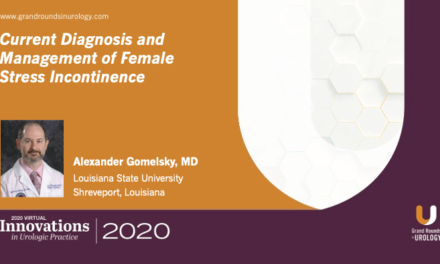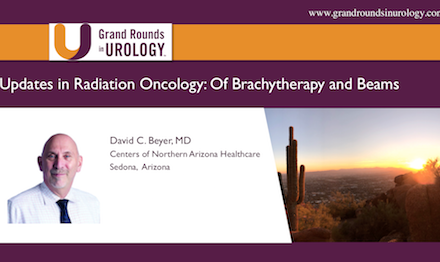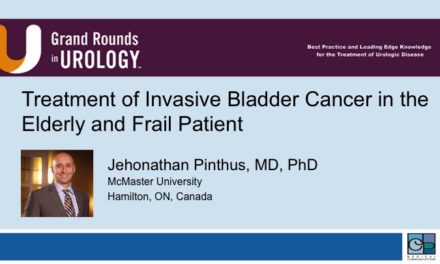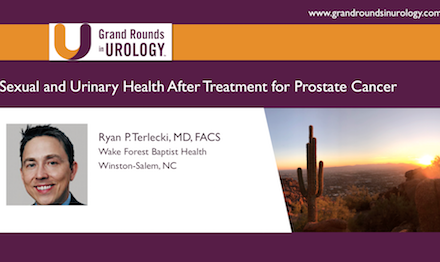Dr. Erik P. Castle, MD, presented “HIFU is not Ready for Prime Time” at the 26th Annual Perspectives in Urology: Point-Counterpoint, November 12, 2017 in Scottsdale, AZ
How to cite: Castle, Erik P. “HIFU is not Ready for Prime Time” November 12, 2017. Accessed Nov 2024. https://dev.grandroundsinurology.com/HIFU-is-not-Ready-for-Prime-Time/
Summary:
Erik P. Castle, MD, argues that using high intensity focused ultrasound (HIFU) to treat prostate cancer, as the technology stands today, results in too many negative quality of life outcomes for patients. Therefore, HIFU is not ready to be a standard of care in urological practices. This is a counter argument to David C. Beyer’s lecture, “HIFU: Ready for Prime Time.”
HIFU is not Ready for Prime Time
Transcript:
Okay, so I think ultimately we have to decide–again, no disclosures–what are we talking about?
Because HIFU has changed over the years, right? We’re talking about whole-gland HIFU, to focal therapy, and hemiablation, and what are we comparing it to, right? Because that’s really going to make the difference in whether you think it’s available for prime time.
The reality is I think the title is a little tough to use in our argument because prime time has various different definitions, whether you’re talking about cancer control, quality of life, is it safe? Most people would say safety is really the key, because the standards for new surgical techniques, radiation techniques, any technology, it’s very different than it is for, say, pharmaceutical drugs, right?
They need randomized trials that show a very specific endpoint, 10, 15, 20 years down the road. With surgery you just have to show that it’s safe and you get it approved. It’s very different; think about how we just try different things in the operating room we don’t have to get FDA approval for. So let’s take a look at this.
I also think you have to decide what your goals are for your patients, right? Because everybody has different goals. Some people it’s cancer control for prostate cancer, for some people it’s–I always kind of give them this talk, it’s a little tongue-in-cheek, and I say, if you came into my office and you had lung cancer or pancreatic cancer, you’d say, doctor, save my life, do whatever it takes, I’ll take whatever you got.
Prostate cancer patients are very different. They show up and they say, doc, I know I have cancer, I want you to cure me, but I do not want my life whatsoever. I want to be the exact same man. I want the same erections, I want to pee the same. In fact, maybe my golf game will be better after you treat me, right? And it kind of makes them feel a little bad, but I think it’s a reasonable expectation, in some sense, because we know that a large majority of prostate cancer we treat is not going to kill a patient over the next 10 or 15 years.
So if we’re going to do something to these patients, we need to make sure that the quality of life expectations, we meet them, or we at least give realistic expectations. A 73-year-old guy who’s barely getting erections with Viagra, it’s unreasonable for him to expect to have erections no matter what treatment he gets, and someone needs to let him know that rather than reading on the internet 99% potency with this or that and no side effects.
What’s their baseline quality of life? There’s a lot of things that–and many of the studies that Dr. Beyer just referred to I’m going to refer to as well, but one thing that has been the biggest problem with HIFU, as we all have heard, is the bladder outlet issues, and the issues with potency, and incontinence as well as retention.
So let’s talk first about whole-gland ablation, and this is where I think HIFU has failed and is not really ready for prime time, and I think where they’re really going, which is the smart thing, is focal therapy. What are the retreatment rates? What are the complications? Who is even eligible for it?
What we have to remember is that whole-gland treatment, whether it’s with cryo or with HIFU, really are not meeting up to the standards of surgery, and the reason I say that is you have to think of it as an entire extirpative procedure, meaning removing the entire glad. It’s very different than when you’re radiating a glad where you’re leaving it situ, because in theory they’re trying to get rid of all the prostate tissue.
Why do they use radiation definitions if they’re getting rid of the entire gland, if that’s what their goal is, if they’re treating the whole gland? If I use the Astro or the Phoenix criteria for prostatectomy, let me tell you, my cancer outcomes will be outstanding.
But with prostate cancer, with radical prostatectomy, we use any detectable PSA that you can argue is 0.2 or 0.4, but they’re a lot stricter and all it takes is one, right? It doesn’t take three and you don’t have to wait almost 18 months for it to be considered a recurrence. So I think it’s an unfair comparison if we’re talking about cancer control using these ablative therapies and radical prostatectomy, which is what you should be comparing it to.
What were some of the outcomes? And these were the older data; you can look at the dates on the slides. This was the original data that came out, and I think this is probably what held it up in getting its FDA approval, was there were significant positive re-biopsy rates, depending on what the PSA NADIR was.
Not insignificant when you’re looking at what their PSA was, and not all these men would get down to it, and they were probably treating everybody, right? Large glands, everything that was out there.
This was the biochemical recurrence-free rate originally in the earlier data that we were seeing out of Europe.
What else did we do? They had one study where they–actually, two series–that they did a radical prostate after HIFU; what did they find? It left vital tissue ventrally and laterally, and they actually a lot of patients that, not insignificantly, that had residual cancer after treatment. And this is what put that question in our minds about the efficacy of the treatment. Now, this you could make the argument it was version 1.0 of HIFU, but it’s something we need to be thinking about with any ablative therapy.
This was TURP followed by HIFU. Now, remember; now you’re getting two procedures, right? TURP and HIFU, sometimes an SP2, which is what really was going on with these, and you’ll see what we saw as far as rates of what the size was, how long they had their SP2s, which often they have to have peri-operatively, no different than with cryo. The grade of incontinence; look how much worse it was versus after having the TURP.
UTI rates, actually, were a lot higher than what we really remember originally, and you could make the argument that it probably had UAs that were positive, and then they treated them because they were ablative and they were bleeding a little bit, but an inflammatory appearance in their urine. I’m not sure exactly if they used a culture that was 100,000 colony forming units, but there were a lot of issues.
We had bladder neck contracture rates and how they defined success, again was using radiation criteria, not using surgical criteria. I guarantee you they would fail with that because they very rarely got to a PSA NADIR of less than 0.2. And then the negative biopsy rates were reasonable, but nevertheless, the cancer was not out of the entire gland.
These were some other complications early on that you saw. Prolonged retention was as high as 30% in some of these patients. Some needed TURPs afterwards, they had strictures. We heard about patients coming back with urethral sloughing like we saw with the early cryo series. I mean, it was not insignificant.
And remember why these men chose HIFU; they were looking for that–I want no side effects, doc. I want surgery, but I don’t want any side effects, and that really was not the case. They had perineal pain. Impotence was quite high early on with the treatment.
So now we’ll get back to the data that Dr. Beyer used as well, which I think is better and encouraging, but there are some realistic things we need to consider. These were larger series, a little bit longer. The follow-up was longer. What did we find?
Well, the biochemical recurrence-free rates are basically what you’d see with surgery, with good radiation, any of those. But let’s remember what patient population we’re talking about, which is prostate cancer patients. You could do nothing to them and a lot of them are alive at this time period, regardless if we were only using certain criteria, and depending on how you adjust your criteria.
Survival rates, excellent, but so it would also still be good if we did nothing for these patients. Disease-specific survival was perfect, what you would expect with anybody, because the follow-up is only eight years. But it depends, again, what is your goal?
The retreatment rates are not insignificant; still done, but not insignificant. Look at the obstruction rates, almost 30%. So they either needed additional procedures or they needed interventions afterwards. We don’t see that after radical prostatectomy, and we certainly don’t see that with radiation.
Incontinence, let’s take a look, it’s 13%, 2%, and really anything significant is about less than 5%, and any prostate treatment, I tell my patients, whether you’re getting radiation, whether you’re getting radical prostatectomy, whether you get anything done, the rates of people being exceedingly unhappy, that have such bad incontinence from a urinary lifestyle is about 5%.
Most people do pretty well as long as their expectation are laid out realistically before they’re treated. Fistula rate, about 0.7%. Preserved potency; this was reported by the–it’s only 25%, that means 75%–I’d rather have radiation because I know the potency would be preserved a lot better than that, as long as you’re not getting ADT at the same time.
This is another study, this is 1000 patients. 39% of patients had ADT used in this series. ADT; how can you compare that to surgery? That’s prior to this. I mean, this is basically a very different surgical therapy, surgical treatment. So you know they’re potency is nowhere near what we’re comparing to when we’re talking about another surgical procedure.
So I think these are things that really made whole-gland HIFU less appealing to most of us, and why I don’t think this is–I would rather have radiation than I would have whole-gland HIFU as far as surgery is concerned.
So what were the limitations with whole-gland? You needed a good–a low prostate volume, very similar to what are we talking about, brachytherapy. Just like Dr. Beyer said, we had calcifications that people identified that they explained blocked the beam within the gland itself. We all have been doing prostate biopsies for some time now; you do those ultrasounds and what do you see?
A lot of inflammation and prostatic calcifications, which I think can affect the complete treatment. Higher retreatment rates depending on which series you looked at. A lot of neoadjuvant ADT to treat the glad. A lot of patients got cystostomy tubes to deal with retention, and now if you’re going to do whole-gland they recommend doing a bladder outlet procedure.
So now you’re getting two procedures and you’re really worried about what’s going on there. Now you have additive complications; let’s not forget that just having this procedure, period, has its own complications associated with it, and you need to include that in your complication reporting with whole-gland HIFU.
So here’s really where I think the debate is, and that’s hemiablation and focal therapy, where I think HIFU and most ablative therapies are going to. And why is that? Because we all realize that we’re over-treating prostate cancer, and we’re seeing this pretty nicely in our prostate series, or prostatectomy series.
Many of us are seeing that we’re treating–there was this era in the early 2000s that we were all treating anybody who walked in the door. You came in, you wanted a prostate, I’d do a prostate for you, and it didn’t matter if it was one core or Gleason 6, and that’s changed dramatically. I think you have to decide what you’re looking for.
So I don’t think I would compare hemiablation or focal therapy to what the standard therapy is. These therapies, radiation or radical prostatectomy are for the intermediate to high-risk patient that we’re trying to cure them. We really believe in our minds and hearts that their survival will be impacted by their cancer.
So I think what you really need to compare hemiablation or focal therapy to is active surveillance or watchful waiting. And that, I think, has an issue with this treatment, and that’s the different goals that you expect from that.
What do you get with hemiablation focal therapy? The rates of potency and continence that you would expect when you’re hardly treating the gland. Lower retention rates, but they still were present anytime you inflamed the gland or do anything with it, you have to deal with it. Obviously significantly higher retreatment rates were seen even in these, but they say that well, it’s no problem, you can just retreat them again, so that’s the value of it.
Well, I would argue that the bottom line is active surveillance has no treatment-related side effects. Now, you’re going to have some side effects associated with biopsies and people are looking at anxiety scores and the impact of knowing you have cancer but you haven’t treated it, but the bottom line is either you’re treating a cancer or you’re not treating a cancer.
So I’ll give you an example; my uncle, who is–my family is half-Cuban, and if you know Miami and you know Latins, there’s something that’s very important to them, and I have no problem saying this, and that is potency. He was in his 80s, late 70s, and he was convinced that he still had a good sex life, and so he went to a colleague of mine who’s down in Miami, Fernando Bianco, and my uncle who had low-risk prostate cancer ended up getting focal cryo.
Really it was because he was–I tried to convince him he didn’t need treatment at all. I mean, the man was in his late 70s for Christ’s sake. But he was convinced that he didn’t want to die from cancer, and it’s basically kind of like a meeting in the middle. We’ll give you some treatment to make you feel better, we’ll charge you and make some money and out of it, and by the way, you’re not going to die from it. Hopefully your side effects are lower.
So I think that’s where we need to do a better job with our patients, is giving them realistic expectations, and I think we’re learning we don’t need to treat everybody.
Here’s the bottom line; prostatectomy, you pay up front. The patient pays up front with continence and potency issues. With energy ablation the patient pays more later in life when they have retreatment rates, when they have issues with strictures, they have issues with all of that that we would expect when you’re leaving the prostate gland in situ.
I think active surveillance is better in today’s era for the patient seeking quality of life or preserve quality of life or continence and potency, because really this is what we’re trying to do with the early detection of prostate cancer, determining who really needs treatment. Who should we really be going after? I think we’re doing a better job in 2017 than we did in 2007, but I don’t think HIFU is really there unless you’re really basically saying I’m going to give you a little treatment to make you feel better.
So as far as prime time, I think it depends on how you define prime time. I think whole-glad, my opinion is it’s going to be gone. I think there’ll be people still doing it, just like they are with cryo; it’s regional, you tend to see it more in the Midwest and Northeast.
I think focal therapy is where you’re going to see HIFU go, but I think we’ll also so AS be really the way to go in the future for these patients, and determining when we’re going to treat them. So hopefully I’ve convinced you of the otherwise. Thank you for your attention.
ABOUT THE AUTHOR
Dr. Erik P. Castle is a Professor of Urology at the Mayo Clinic College of Medicine. His surgical expertise includes minimally invasive urologic oncology, including robot-assisted radical cystectomy, prostatectomy, retroperitoneal lymph node dissection, and partial nephrectomy. He has demonstrated many of these procedures internationally, as he pioneered robot cystectomy as well as robot RPLND. He directs the International Laparoscopic Nephrectomy Program in Mexico on behalf of the American Urologic Association (AUA), and also serves on several committees and guideline panels within the American Urologic Association. He is on the Early Detection of Prostate Cancer Panel for the National Comprehensive Cancer Network (NCCN) as well.
Dr. Castle’s research interests include prostate cancer, bladder cancer, and kidney cancer. He is the Director of the Desert Mountain Care Prostate Cancer Research Fund and is the principal investigator of his lab housed at the Mayo Clinic Collaborative Research Building. His basic science research is focused on novel secondary hormonal therapies of prostate cancer and apoptotic pathways related to manipulations of the androgen and estrogen receptors. He also directs the prospectively collected genitourinary biorepository at Mayo Clinic Arizona, which houses over 40,000 specimens.





